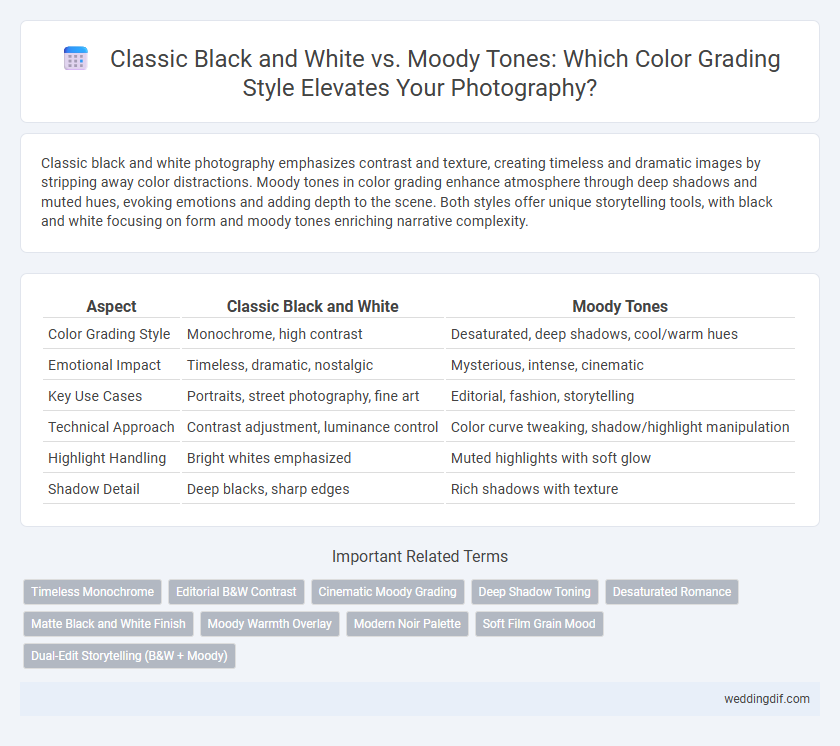Classic black and white photography emphasizes contrast and texture, creating timeless and dramatic images by stripping away color distractions. Moody tones in color grading enhance atmosphere through deep shadows and muted hues, evoking emotions and adding depth to the scene. Both styles offer unique storytelling tools, with black and white focusing on form and moody tones enriching narrative complexity.
Table of Comparison
| Aspect | Classic Black and White | Moody Tones |
|---|---|---|
| Color Grading Style | Monochrome, high contrast | Desaturated, deep shadows, cool/warm hues |
| Emotional Impact | Timeless, dramatic, nostalgic | Mysterious, intense, cinematic |
| Key Use Cases | Portraits, street photography, fine art | Editorial, fashion, storytelling |
| Technical Approach | Contrast adjustment, luminance control | Color curve tweaking, shadow/highlight manipulation |
| Highlight Handling | Bright whites emphasized | Muted highlights with soft glow |
| Shadow Detail | Deep blacks, sharp edges | Rich shadows with texture |
Defining Classic Black and White and Moody Tones in Wedding Photography
Classic Black and White photography in wedding color grading emphasizes high contrast, sharp details, and timeless elegance by removing color to highlight emotions and textures. Moody Tones, conversely, use desaturated colors, deep shadows, and a muted palette to create a dramatic, intimate atmosphere that evokes nostalgia and depth. Both styles define visual storytelling differently, with Classic Black and White offering purity and simplicity while Moody Tones present complexity and emotional richness.
The Historical Appeal of Black and White Wedding Photos
Classic black and white wedding photos evoke a timeless elegance rooted in photographic history, emphasizing contrast, texture, and emotion without the distraction of color. The absence of color directs attention to composition and expressions, creating an enduring narrative that resonates through generations. Moody tones, while atmospheric, often imbue images with contemporary drama, whereas black and white retains a purist, nostalgic appeal cherished in wedding photography traditions.
Emotional Impact: Black and White vs Moody Tones
Classic black and white photography emphasizes contrast and texture to evoke timeless emotions, often highlighting raw human expressions and simplifying the visual narrative. Moody tones in color grading use deep shadows and muted colors to create a dramatic, atmospheric effect that intensifies feelings of mystery, melancholy, or tension. Both styles rely on tonal manipulation to influence emotional perception but differ in their approach: black and white underscores purity and nostalgia, while moody tones enhance mood complexity through color nuance.
Creating Timelessness: Why Black and White Endures
Black and white photography creates timelessness by emphasizing contrast, texture, and composition without the distraction of color, allowing viewers to focus on the emotional depth and story within the image. Classic black and white images endure because they evoke nostalgia and a sense of permanence, transcending trends and technological changes in photography. Moody tones in color grading can convey atmosphere and emotion but lack the universal, enduring appeal achieved through monochromatic simplicity.
Artistic Storytelling with Moody Tones
Moody tones in color grading create a dramatic atmosphere by emphasizing deep shadows and muted highlights, enhancing the emotional depth in photography. This approach to artistic storytelling uses contrast and subtle color shifts to evoke mood and narrative complexity, making images feel immersive and expressive. Unlike classic black and white, moody tones retain color nuances that add layers of meaning and intensify visual storytelling.
Color Grading Techniques for Both Styles
Classic black and white color grading focuses on high contrast and balanced grayscale to emphasize textures and shapes, enhancing timeless and dramatic aesthetics. Moody tones utilize deep shadows, desaturated colors, and cool or warm overlays to evoke emotional depth and atmosphere in the image. Mastering curves adjustment, selective color correction, and film grain application are essential techniques for effectively achieving both styles in photography.
Client Preferences: Guiding Couples on Style Choices
Clients often gravitate towards classic black and white color grading for its timeless elegance and ability to highlight emotional expressions without distraction. Moody tones, with their rich shadows and deep contrast, evoke a dramatic atmosphere preferred by couples seeking a contemporary and intense visual narrative. Understanding these preferences helps photographers guide clients in selecting a style that best complements their wedding story and personal aesthetics.
Lighting and Composition: Adapting for Each Look
Classic black and white photography emphasizes strong contrasts and refined lighting to highlight textures and shapes, enhancing composition through shadows and light interplay. Moody tones in color grading rely on subdued, often cooler lighting with limited color palettes to create depth and evoke emotional atmosphere. Adapting composition for each style requires balancing light intensity and direction to support the intended visual narrative and mood.
Pros and Cons of Each Color Grading Approach
Classic black and white photography emphasizes contrast and texture, creating timeless and dramatic images that highlight form and emotion without distraction from color; however, it limits the expression of mood that color can provide. Moody tones in color grading enhance atmosphere through deep shadows and muted colors, offering rich storytelling potential but sometimes risking oversaturation or loss of detail in darker areas. Choosing between these approaches depends on the desired emotional impact and narrative style of the photograph.
Choosing the Right Style for Different Wedding Moments
Classic black and white photography emphasizes timeless elegance and emotional depth, perfect for capturing intimate wedding vows and heartfelt portraits. Moody tones use deep shadows and rich contrast to evoke dramatic, atmospheric scenes ideal for reception festivities and evening celebrations. Selecting between these styles depends on the mood desired for each moment, balancing nostalgia with cinematic intensity.
Classic Black and White vs Moody Tones for color grading. Infographic

 weddingdif.com
weddingdif.com